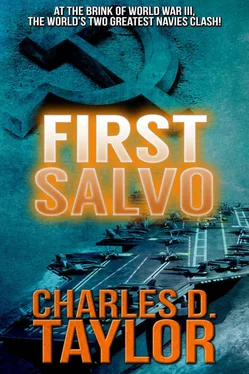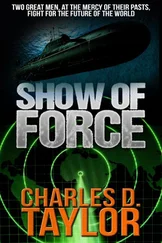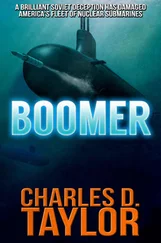With a certain reluctance on the part of a number of members of the State Committee for Defense, preliminary orders were transmitted to the Strategic Rocket Forces. Their hesitation was based on a mistrust of General Colonel Melekhin. He was not of the old crowd, like Keradin. Melekhin was young; he had advanced rapidly because of his political connections. Yet there was a concern among the older members that he was trigger happy — that he was willing to act possibly on his own rather than under their strict orders. They saw the Strategic Rocket Forces as a threat in itself, not as a weapon that would be placed in action as part of an overall scheme. Many of the older members envisioned the awful specter of retaliation. They saw this war simply as an opportunity to expand the Motherland’s boundaries, and they could not accept the idea of ICBMs raining down on their country. They would rely on Melekhin if it became absolutely necessary, but their final hope lay in the fact that General Keradin had yet to surface. His disappearance had created dissension and an inability to use the Strategic Rocket Forces as they had once anticipated.
With that in mind, Moscow determined that the final phase should commence in the Mediterranean slightly ahead of schedule. The American carrier battle groups had taken a beating, but they still retained the capability to defend themselves. The orders were given for the lead ships, with Kharkov , to open fire with their missiles on the perimeter defenses. Those would be the ASW ships under Admiral Pratt’s command which were already hard pressed by the persistence of Soviet missile submarines.
A cruise missile launched at a surface ship by a submarine or another surface ship can be a formidable weapon if properly employed. Skimming the surface of the ocean above the speed of sound, it is extremely difficult to track. Quite often, the first warning of its approach is given when its homing device locks on the targeted ship. By then, it is often too late to effect any defense other than the last-ditch one — Phalanx.
A signal was transmitted to the Soviet submarines. They were to surface to assist in the control of the first missiles. With midcourse guidance, the range of the missiles from the surface ships would be tripled. The Russians were concerned about the longer range of the Harpoon missiles aboard the American ships. Exposing their remaining submarines was a desperate move.
For those submarines, surfacing could be a deadly strategy. Their natural element was underneath the sea, and it was there that they enjoyed a true advantage. On the surface, they were simply slower, unwieldy ships no longer able to utilize secrecy as a major defense — they were fish out of water.
It was a surprise to Admiral Pratt’s beleaguered ASW ships and aircraft when the subsurface contacts they had been so intent on holding down to deny use of their missiles appeared on the surface. The purpose of this illogical exposure was not immediately evident. Fire-control solutions, whether with torpedoes, missiles, or even guns were executed with ease. The quarry was attacked and destroyed, one by one.
The purpose of these subs’ committing certain suicide was not apparent until missile-warning detectors were activated in Kennedy ’s battle group. The Soviet missiles wreaked havoc with the perimeter force. It took little time for the Soviet submarines’ radars to lock on their targets, transmit the fire-control information to the missiles, and, if they had survived that long, to dive.
New guided-missile frigates like John Hall or Stephen Groves had little chance against the huge warheads. They were literally blown out of the water. Larger ships, Spruance-class destroyers like Caron or John Rodgers , survived the missiles, though severely damaged. But the combination of missiles and then torpedoes finished them.
Dave Pratt realized in Yorktown ’s CIC that the two opposing forces — the Soviet subs and the American perimeter defense — were now neutralized. There would be little more contribution from them to either side. The Battle of the Mediterranean was drawing to a close. How it ended would be based on which surface force survived. If Nelson’s sweep to the south proved effective over the next hour, and the Soviet submarines in that area were prevented from launching missiles, it would come down to an old-fashioned faceoff between the main elements of two battle groups, just as had occurred generations before during the Second World War.
The undersea battle had run its course. The combatants in the air war had been exhausted.
ABOARD U.S.S. BRISCOE , HEADING NORTH TOWARD THE MAIN BATTLE GROUP
Wendell Nelson had been correct. The Russian submarines heading in his direction reversed course directly into the sweep line coordinated by Nicholson. It was a textbook execution, even more effective than the first one Nelson had demonstrated two days previously. The three destroyers and three frigates in Nicholson ’s squadron each were flying helicopters. This doubled their force effectiveness, likely outnumbering the submarines they faced, and the helos were phantoms to the subs, appearing out of nowhere, unpredictably, when least anticipated.
The Soviet submarines’ speed advantage was negated by the tactics Nelson had refined back in Newport. Not one of the subs was able to gain time or position to fire its cruise missiles. It became an action of attrition. Over a forty-minute period, five submarines were sunk by homing torpedoes. At the same time, two of the three frigates, somewhat slower and unable to survive if even one shaft was damaged, were sunk.
As Briscoe approached from the rear of the battle, unrecognized by the desperate submarines, Nicholson took a torpedo forward. In a series of violent explosions, first in the magazine under her forward gun mount, then as flames consumed the warheads in her ASROC launcher, Nicholson was blown apart in sections. As flames swept the remainder of the ship, a final blast in her fuel tanks sent her to the bottom.
Nelson ordered Briscoe into range with her ASROC-launched torpedoes. He was positive they had caught one more submarine when a tremendous explosion rocked Briscoe. She had been detected after all. The torpedo had not been deterred by her decoys. Instead, it struck aft, and in a series of explosions, the ship lost steering gear and both screws. Helpless, Briscoe wallowed in the swells, flames sweeping into the after magazines. Damage control lost water pressure. Though her forward weapons were capable of continuing the fight, Briscoe could no longer maneuver. Fires, now out of control, soon swept through her electrical system.
Once again the confrontation had been fatal for both sides. Out of the force that Wendell Nelson had taken south for Admiral Pratt, two destroyers now turned north to rejoin the battle group. Nelson transferred to his third ship that day, and headed north aboard Samuel Eliot Morison , one of the few guided-missile frigates to survive.
Wendell Nelson found the last few rungs of the ladder to Morison’ s bridge suddenly very steep. He’d never been aboard one of the little ships. Were they really built so oddly or was exhaustion sweeping over him?
Morison ’s captain extended a welcoming hand as Nelson ambled slowly into the pilothouse. “I know this isn’t the type of luxury you’re used to…”
Nelson smiled wearily. “Captain, if this little fellow can stay afloat for the remainder of the day, that’s enough luxury for me.” He let the commanding officer’s hand go, sagging tiredly against the chart table. “You know I hate to admit it, but I didn’t even see the name on the fantail when you came alongside for me, or it just didn’t register.”
Читать дальше












